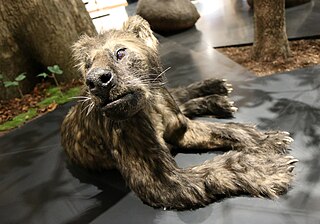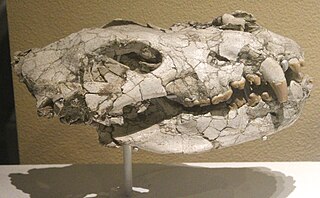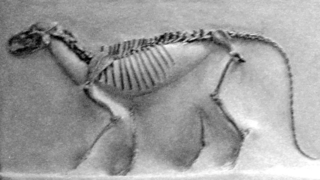
Amphicyonidae is an extinct family of terrestrial carnivorans belonging to the suborder Caniformia. They first appeared in North America in the middle Eocene, spread to Europe by the late Eocene, and further spread to Asia and Africa by the early Miocene. They had largely disappeared worldwide by the late Miocene, with the latest recorded species at the end of the Miocene in Africa. They were among the first carnivorans to evolve large body size. Amphicyonids are colloquially referred to as "bear-dogs".

Miacidae is a former paraphyletic family of extinct primitive placental mammals that lived in North America, Europe and Asia during the Paleocene and Eocene epochs, about 65–33.9 million years ago. These mammals were basal to order Carnivora, the crown-group within the Carnivoraformes.

Miacis is an extinct genus of placental mammals from clade Carnivoraformes, that lived in North America from the early to middle Eocene.

Amphicyon is an extinct genus of large carnivorans belonging to the family Amphicyonidae, subfamily Amphicyoninae, from the Miocene epoch. Members of this family received their vernacular name for possessing bear-like and dog-like features. They ranged over North America, Europe, Asia, and Africa.

Carnivoramorpha is a clade of placental mammals of clade Pan-Carnivora from mirorder Ferae, that includes the modern order Carnivora and its extinct stem-relatives.

Ursoidea is a superfamily of arctoid carnivoran mammals that includes the families Subparictidae, Amphicynodontidae, and Ursidae. The last family includes the extant lineages of bears, as well as the extinct Hemicyoninae and Ursavinae.

Miocyon is an extinct genus of placental mammals from clade Carnivoraformes, that lived in North America from the early to late Eocene.

Quercygale is an extinct genus of placental mammals from the clade Carnivoraformes, that lived in Europe during the early to late Eocene.

Agnotherium is a genus of large sized carnivoran mammals, belonging to the Amphicyonidae, which has been found in Western Europe, and possibly China and Northern Africa, and lived during the Late Miocene epoch. Despite only being known from fragmentary remains, the genus notable for hypercarnivorous adaptions, which have been said to represent the "apex" among its family.

Gobicyon is an extinct genus of large-sized carnivoran mammals, belonging to the Amphicyonidae, that was discovered in China, Mongolia, and Serbia, and lived during the Middle Miocene epoch. Despite only being known from rather fragmentary remains, recent discoveries showcase that it was an aberrant member of the subfamily Haplocyoninae, with adaptions towards bone-crushing similar to those of a hyaena.

Ysengrinia is an extinct genus of carnivoran in the family Amphicyonidae, that lived during the Late Oligocene to Early Miocene. Fossil remains have been discovered in Western Europe, the United States and possibly China. The European species are among the earliest known members of the Thaumastocyoninae, a group of aberrant amphicyonids showcasing hypercarnivorous adations, but are only known from fragmentary remains. The American species is much better preserved and shows a robust, black-bear sized predator. These fossils play an important role in our understanding of the biotic interchange between Eurasia and North America during the earliest Miocene. However, more recent research suggests that the genus might be polyphyletic, and that several of its species should be excluded from Ysengrinia.

Arctoidea is a clade of mostly carnivorous mammals which include the extinct Hemicyonidae (dog-bears), and the extant Musteloidea, Pinnipedia, and Ursidae (bears), found in all continents from the Eocene, 46 million years ago, to the present. The oldest group of the clade is the bears, as their CMAH gene is still intact. The gene became non-functional in the common ancestor of the Mustelida. Arctoids are caniforms, along with dogs (canids) and extinct bear dogs (Amphicyonidae). The earliest caniforms were superficially similar to martens, which are tree-dwelling mustelids. Together with feliforms, caniforms compose the order Carnivora; sometimes Arctoidea can be considered a separate suborder from Caniformia and a sister taxon to Feliformia.

Gustafsonia is an extinct genus of carnivoran belonging to the family Amphicyonidae. The type species, Gustafsonia cognita, was described in 1986 by Eric Paul Gustafson, who originally interpreted it as a miacid and named it Miacis cognitus. It was subsequently considered to be the only species of the diverse genus Miacis that belonged to the crown-group Carnivora, within the Caniformia, and it was ultimately assigned to the family Amphicyonidae. The type specimen or holotype was discovered in Reeve's bonebed, western Texas, in the Chambers Tuff Formation in 1986. The University of Texas holds this specimen. It is the only confirmed fossil of this species.

Brachyrhynchocyon is an extinct genus of terrestrial carnivore, which belonged to the family Amphicyonidae of the suborder Caniformia.

Magericyon is an extinct genus of Amphicyonid ("bear-dog") that lived during the Miocene 10-9 Ma in what is now Spain.

Thaumastocyoninae is an extinct subfamily of amphicyonids, large terrestrial carnivores, which inhabited what is now Europe during the Miocene epoch. The subfamily was erected by Hürzeler (1940), and is defined by the complete suppression of m1 metaconid, reduction of the premolars, except the p4, which is reinforced, and the oblique abrasion of the teeth, and the possession of hypercarnivorous tendencies. Thaumastocyonines are poorly known, with only about 65 dental specimens, most of those isolated teeth, being known as of 2020, although more complete remains have recently been discovered.
Myacyon is an extinct genus of large sized carnivoran mammals, belonging to the family Amphicyonidae, that lived in Africa during the Miocene epoch. Due to the limited scope and fragmentary nature of the severely damaged holotype, as well as the illustrations in its descriptions, which have been called inadequate, usage of this genus poses serious issues. However, it is notable for being one of the last surviving members of its family and its adaptions to hypercarnivory. Its relationships to other amphicyonids are obscure, and it is not closely related to Bonisicyon, the other late surviving African genus, although it has been proposed that it descends from a species of Cynelos or Namibiocyon.
Bonisicyon is an extinct genus of carnivoran mammals, belonging to the family Amphicyonidae. It is the last-surviving member of its family, living in East Africa during the end of the Miocene epoch. Known only from a damaged mandible and isolated teeth from the Nawata Formation, and possibly also the Lukeino Formation, its closer taxonomic affinities are unclear. It is notable for both its small size, and its unique dentition.
Namibiocyon is an extinct genus of carnivoran mammals, belonging to the family Amphicyonidae, that lived in Namibia during the Early Miocene epoch. Before the erection of this taxon in 2022, the type and only species, N. ginsburgi, had been assigned to a variety of other genera. It is notable for its adaptions toward hypercarnivory.
Peignecyon is an extinct genus of large carnivorans belonging to the family Amphicyonidae. It belongs to the subfamily Thaumastocyoninae, which is characterized by their adaptions towards hypercarnivory. Whereas most other thaumastocyonines are often only known from fragmentary remains and isolated teeth, Peignecyon is known from a variety of well-preserved remains. It contains a single species, P. felinoides from the Early Miocene of the Czech Republic.
















